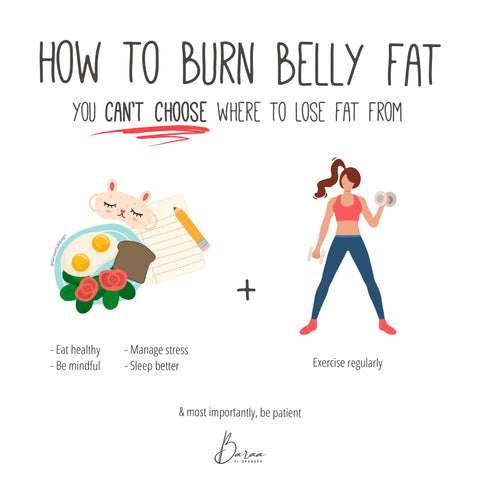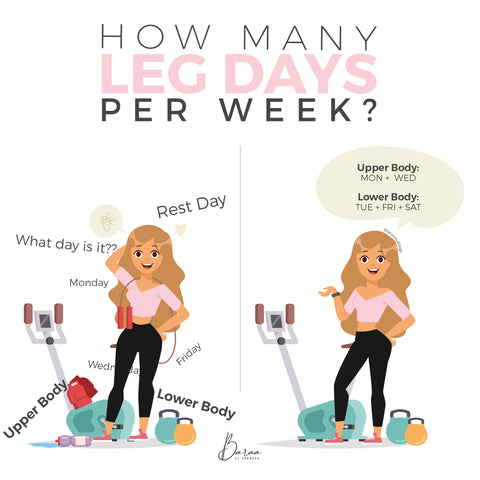How Many Leg Days Should I Be Doing? By Baraa El Sabbagh, Personal Trainer and Sports Nutritionist in Dubai
Jun 14, 2021
Today, we’re going to be talking about how often we should train each muscle group to really see progress and development. If you’re always hearing about leg day this and leg day that, keep reading to find out exactly how often you should be training your legs and other muscles to see results. Also, if you want to hear the episode instead, there’s always the podcast! Check out episode #88 of B for Better Health to hear this info on your next drive or walk.
Get ready to start fresh with your training, or keep going as you’ve been doing, by understanding just how much work each muscle group is meant to be doing.
Is This The Same As Spot Reduction?
You’re not training each body part because that’s where you want to lose weight from or tone up, that’s called spot reduction and it does NOT work. I talk all about that in my highest downloaded episode to date called “How To Lose Belly Fat”, which also refers to thigh fat, arm fat, and all that jazz.

The reason we dedicate certain days to certain body parts is to ensure equal strengthening all over the body! And some muscle groups require more attention than others, so let’s find out what they are and what we can do to ensure a balanced, strong body.
Importance of Full Body Workouts
If you’re just starting your weight loss and muscle gain journey, I would start you off with full body training, no question. Why do I do that? Because we need to strengthen your entire body before we begin to address certain points. This will flatten any imbalances in your body until you’re ready for a split approach. As a beginner, you won’t be able to complete a full 60 minute workout just for LEGS. You’re going to start shaking by minute 20 and would have no energy to finish the session.
The Benefits Of A Full Body Session
A full body training would include 2 or 3 moves that are legs focused, then it would incorporate some upper body workouts, along with a few core and ab exercises, and we can call it a day.
After doing full body workouts for a couple of weeks or months, you can then move onto a different training method. This way, you’re stimulating all muscle groups and strengthening them at the same time so that when you get to the point of doing just arm or legs focused sessions, you have the ability to make it to the end of the workout!
Recommended Number Of Days For Each Muscle Group
The ideal number of days for each muscle group is: 2 to 3 times a week, depending on the muscle. By doing this, you increase something called the Muscle Protein Synthesis in the muscle group you’re training.
Did I lose you there? I know it might sound complicated, but stay with me team! When you train a muscle group, you’re enhancing the protein synthesis in that area, which is KEY in building new muscle! You increase this magic protein synthesis whenever you train a specific muscle group, and the effect lasts about 2 days after training, meaning its still feeding and growing the muscle. Score!
Building Muscle Doesn’t Mean Bulking

Just for the record, when I say “building and growing muscle”, it doesn’t automatically mean bulky, it simply describes the way muscles work. It can sometimes refer to bulky but it can also refer to the sexy, toned looking muscle that helps your body function at its best. To get bulky requires so much more training and effort, plus a calorie surplus. So don’t be worried about putting in the work because you’re afraid to become bulky, trust me it won’t happen! Athletes work for years to see the bulk you’re avoiding.
Back to Muscle Protein Synthesis
If you did leg exercises on a Sunday, you’re still reaping the rewards by Tuesday. All because of muscle protein synthesis. Your leg muscles are still building even if you didn’t do any leg exercises the following 48 hours. This is great news because it means you don’t have to train a muscle group 7 days a week to see a difference.
All you have to do is work each group a couple of times a week to keep the protein synthesis around and doing its job! Of course, the more you train, the more you’re increasing the MPS, the more potential for muscle building. But there’s a fine line and we don’t want you to be overtraining a muscle group. That’s why there’s rest days and why you can’t be training legs with every workout during the week, they need to recover and heal to gain the benefits.
You’re Actually Working Everything All Week
Now, let’s say you’re doing a program and you’re noticing that you are not training your abs and core except once a week. How will your core get stronger if you’re training it once a week? Well, and I can’t 100% confirm this without looking at your workouts, but chances are you are getting in some core work in all your training days if you’re doing it right.
Let’s take the example of a deadlift, this exercise targets your core, upper-mid-and lower back, as well as your glutes and forearms! Several muscles are involved here. Same thing when you’re actually doing a core exercise. You’re not just targeting your core, but multiple muscle groups as well.Another example is the plank. When you’re planking, you’re using your chest, shoulders, upper back, and abdominal muscles. So trust the process, trust the program, your guide or trainer has got you covered (hopefully!)
Compound And Isolation Exercises
Squats, lunges, and deadlifts are all examples of compound exercises and they are super helpful in the world of training because they target 2 or more muscles at one time. The opposite of compound exercises are isolation exercises, which target one muscle group at a time.
I’m going to share a fun tip you guys can try at the gym the next time you’re crunched for time. You can turn an isolation exercise into a compound one. This way, you’ll make sure you’re hitting more than one muscle group with one move, allowing you to do MORE exercises and hit MORE muscles.
Example 1: Doing a bicep curl on its own will strengthen your biceps. This is an isolation exercise. It’s essential if you’re working on strengthening and balancing your muscles groups.
But when you’re crunched on time, you can turn it into a compound exercise by adding a lunge to it! Now you’re hitting your abs, quads, hamstrings, glutes IN ADDITION to your biceps & you can call it lunge to bicep curl!
Example 2: Another one you can do is the shoulder press. On its own its targets the shoulders. But if you incorporate a squat with it, you’ve just added legs, abs and glutes to the mix since you’re using your entire body to do the motion. You can call this one, squat to shoulder press.
Let’s Talk About Workout Frequency
If you’re doing low intensity sessions, you can work out more during the week since your body can recover quite quickly. But if you’re doing high intensity sessions, you need MORE time to recover! So you would workout a specific muscle group less during the week. This is because high intensity sessions need longer periods of recovery,
Which is the reason we don’t recommend HIIT more than 3 to 4 times a week: cause its high intensity and puts pressure not just on the muscle, but the joints too. Having said that, studies do show that training 3 times a week will increase muscle mass more than if you train 1 or 2 times per week, especially if you’re just starting out as a beginner.
So here’s how it would go: As a beginner, aim to train 2 to 3 times a week. This is great if your aim is general health and wellness. Your trainer will make sure to hit all the muscle groups within those days. The more advanced you get, the more days you’re going to need to train to see a change. So aim to hit the gym 4 to 6 times a week for more noticeable muscle growth.
How To Split Up Those Days?
The gold standard is allowing your muscle groups to be trained 2-3 times per week, while allowing 48 hours of rest in between. So an EXAMPLE of a 5-day advanced split can look like this:
Monday: Chest, shoulders, triceps
Tuesday: Legs, focus on quads
Wednesday: Rest to allow for 48 hour recovery
Thursday: Back & biceps
Friday: Legs, focus on hamstrings
Saturday: Rest
Sunday: Legs, focus on glutes
There’s actually several other methods. I’m going to run through them very briefly so you can be fancy next time you’re talking about fitness!
The Push/Pull/Leg Method
With push day, you train all upper body pushing muscles, like chest shoulders and triceps. With pull day, you’re training all upper body pulling muscles, like the back and biceps. Then on legs day, you workout the entire lower body, like quads, hamstrings, glutes, calves and abdominals.
But remember, this is not set in stone, because changing things up and challenging the muscle is always a good idea. Other ways trainers can design programs is by:
- Alternating between upper and lower body within or between sessions
- Combining pushing and pulling exercises within a session
- Doing supersets or compound sets within a workout with little rest in between
I know a lot of you are curious on how I split my workout days and it’s similar to the 5 day workout split I mentioned earlier. I usually dedicate 3 days to my lower body muscles as they are one of the biggest muscle groups and I want to have more definition in that area. I train my upper body 2 days per week & I have 2 lovely well-earned rest days. I sprinkle some yoga and dance sessions to keep things fun!
Why You Shouldn’t Get Used To Your Workout
One last important thing to remember: don’t let your muscles get too used to something. If you’re working your shoulders and triceps the same way for 12 weeks, you’ll stop noticing a difference after the first month. Sure, they got stronger and more muscular, but after a certain period of time, you will plateau and need a program update to reveal more muscles and strength.
Home Improvements For Amping Up Your Workout

And now to conclude this post, here are some home improvement tips to try!
- Begin with a program that targets each muscle group 2 or 3 times a week. This way you’re strengthening your entire body and elevating muscle protein synthesis all week in all parts of the body.
- If you’re on vacation or it’s crazy at work and you can only train 3 times a week, try hitting 2 muscle groups on the same day with compound exercises.
- When you feel you’ve progressed enough, think about splitting the days up.
- Get in touch with a personal trainer or an instructor to find out whether the program you’re on is working for you! You need to change things up every 3 months to ensure maximum development and growth.
Thank you so much for reading till the end everybody! I’ll catch you next week.
Subscribe to one of the top 5 UAE podcasts.
Stay connected with news and updates!
Join our mailing list to receive the latest news and updates from our team.
Don't worry, your information will not be shared.
We hate SPAM. Great content only!


